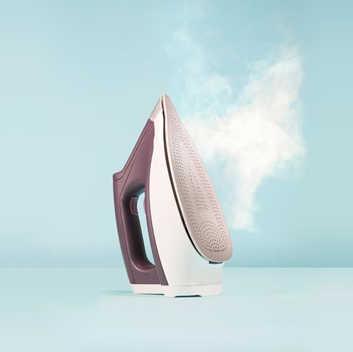Steam Iron

The law of energy conservation affects our daily life. The law of energy conservation holds that the energy neither be generated nor destroyed, only transformed. Unless external energy is provided, a system's energy level remains constant. In non-conservative forces, energy is transformed from mechanical to thermal, but the overall energy remains constant. The only way to utilise energy is to change its form. A everyday appliance is a steam iron.
In addition, the setam iron obeys the rule of thermodynamics. In equation form, the first law of thermodynamics is
ΔU = Q – W
where
ΔU= the change in internal energy U of the system.
Q= the net heat transferred into the system.
W=the net work done by the system.
A steam iron is an electric iron that generates steam through holes on its flat surface to help iron totally dry items. A steam iron is a pressing iron with a compartment for water that is heated by the iron and discharged as steam through the sole plate onto the fabric. This method helps flatten the cloth and remove wrinkles. To make the cloth more attractive Irons, which utilize heat to remove creases from clothing, This approach is centuries old. Modern irons use setam to efficiently press clothing while reducing the risk of burning them. Henry W. Seeley created the first iron in 1882 that used electrical energy to generate heat instead of coal and sand.
This invention saves time and reduces the danger of fabric burns by controlling the iron's temperature. It is also lot lighter and easy to handle. Heat alone does not totally remove the fabric's binding. So came the steam iron.
To release hydrogen bonds, use a steam iron. Then pressure aligns the molecules. Finally, the heat evaporated the water and reconnects the hydrogen bonds. The hotter the iron, the faster the fabric's moisture evaporates and the hydrogen bonds regenerate. In short, hotter ironing removes creases quicker. Your garments may get ruined, shrink, or shine if they are not heat-resistant.
The steam iron and dry iron (regular iron) have a similar physical notion. Both steam and dry irons are heated by electricity, converting electrical energy to heat energy. Amount of heat needed to increase the temperature needed can be calculated using this formula:
Q = m cp dT
where
Q = the quantity of energy or heat (kJ) m = the mass of substance (kg)
cp = the specific heat of substance (kJ/kg oC )
Material properties and heat capacities common materials
dT = the temperature rise of substance (oC)
Electric heating is the conversion of electrical energy to heat. Heating, cooking, water heating, and industrial procedures are all common. A steam iron is an electric heater. The heating element of an electric heater is just an electrical resistor, which in a steam iron is a nichrome wire embedded in a mica sheet. The nichrome wire then receives an alternate current (AC) that turns electrical energy into thermal energy. Due to I2R loss, the nichrome wire warms up. Thus the longer the current flows through the nichrome, the hotter the heating element. Mica sheet is also used as a heating element cover since it is an excellent insulator and can resist high temperatures. The active element is most temporary electric heaters is nichrome wire.
The steam iron also features a thermostat. A thermostat is a device that rotates with temperature. Thus thermostat is made of two bi-metallic strips. Each of the two strips has a distinct thermal expansion coefficient. Their coefficients of variation are different. Thermodynamics at any given temperature, one metallic strip bends more than the other. An electric iron is first connected to the power source. Assume the knob is now at its lowest setting. In this scenario, when strip 2 reaches 100°C. It bends sufficiently to break the live wire-to-strip 1 connection. The iron is now off. In time, strip 2 contracts, re- establishing the electric connection and turning on the electric iron. Assume the knob is now at its highest point. In this scenario, when strip 2 reaches 200°C. It bends sufficiently to break the live wire-to- strip1 connection. The iron is now off. In time, strip 2 contracts, re-establishing the electric connection and turning on the electric iron.
Authors : Samuel Izzati, Aishah & Gs. Dr. Ya'akob Mansor
Tarikh Input: 20/12/2023 | Kemaskini: 20/12/2023 | emma
PERKONGSIAN MEDIA



























